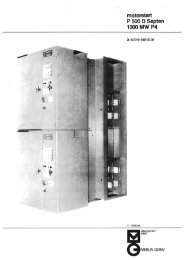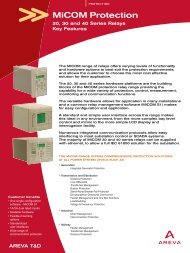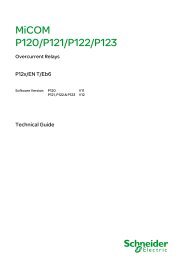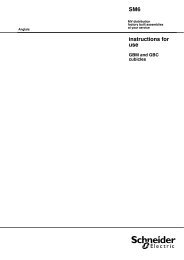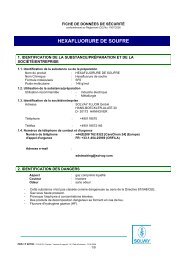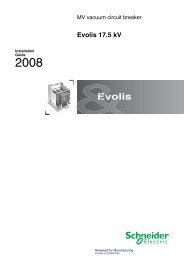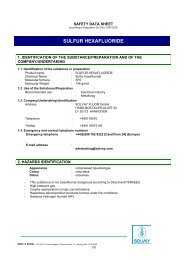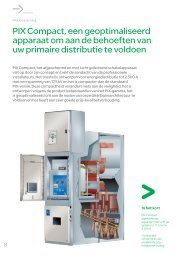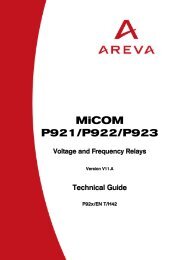<strong>The</strong> pr<strong>in</strong>ciple consists of measur<strong>in</strong>g andcompar<strong>in</strong>g voltages between the (+) polarity andthe earth, on the one hand, and the (-) polarityand the earth on the other. This pr<strong>in</strong>ciple makesauxiliary power sources unnecessary, s<strong>in</strong>ce thenetwork supplies the PIM directly viameasurement sensors (resistances).This technique applies to two-phase AC and DCnetworks and does not allow live fault track<strong>in</strong>g.For AC networks<strong>The</strong> most commonly used PIM are those with<strong>in</strong>sulation measurement by DC current <strong>in</strong>jection.Permanent measurement of <strong>in</strong>sulationresistance required use of active <strong>system</strong>s <strong>in</strong>place of the previously used passive <strong>system</strong>s.This resistance can be measured accurately <strong>in</strong>DC (see fig. 11 ), which is why the first PIMs,placed between the network and the earth,<strong>in</strong>jected a low DC current which flowed throughthe fault. This simple, reliable technique is stillextensively used today, but does not allow livefault track<strong>in</strong>g.Note that when these PIMs are used on mixednetworks (conta<strong>in</strong><strong>in</strong>g rectifiers without galvanic<strong>in</strong>sulation), they may be disturbed or evenVNI PIM321NPEI PIMR BFig. 11 : pr<strong>in</strong>ciple of PIM with current <strong>in</strong>jection.“bl<strong>in</strong>ded” if a fault is present on the DC part ofthe network.<strong>The</strong>se were followed by PIMs with AC current<strong>in</strong>jection at low frequency (< 10 Hz), operat<strong>in</strong>gon the same pr<strong>in</strong>ciple. Although these PIMsallow live fault track<strong>in</strong>g, they can be “misled” bycable capacities that are seen as <strong>in</strong>sulationfaults and disturbed by frequency converters(variable speed controllers).For all AC and DC networksF<strong>in</strong>ally, nowadays, given that networks arefrequently of the mixed AC/DC k<strong>in</strong>d as well asvariable frequency, the new PIMs are able tomonitor <strong>in</strong>sulation on all types of networks.c Some use squared wave pulses at very lowfrequency (≈ 1Hz). <strong>The</strong>y allow PIM not to bedisturbed by earth leakage capacities, as theyare then immediately loaded then unloaded bythe next strobe pulse of opposite sign. <strong>The</strong>y areuniversal <strong>in</strong> use and easily adapted to modernnetworks, <strong>in</strong> particular to those supply<strong>in</strong>g powerelectronic devices which often deform the ACpulse. However, their response time, depend<strong>in</strong>gon the network’s earth leakage capacity, may beas much as a few m<strong>in</strong>utes and does not allowthe detection of <strong>in</strong>termittent faults.c In order to compensate the usage restrictionsof these PIMs for very long networks andnetworks with a large number of capacitivefilters, the low frequency AC current <strong>in</strong>jectiontechnique has been improved by means of“synchronous demodulation” (see fig. 12 ): thistype of PIM applies a low frequency AC voltagebetween the network and the earth, measuresthe current flow<strong>in</strong>g back via network <strong>in</strong>sulationimpedance and calculates the voltage-currentshift.It is then possible to determ<strong>in</strong>e the resistive andcapacitive components of this current and thusrelate the threshold to the resistive componentonly. This upgrade, the result of digitaltechnology, comb<strong>in</strong>es the advantages of DCcurrent and low frequency AC current <strong>in</strong>jectionwithout their disadvantages.I BFBF~mAVI R-BF= U BFU BFR NetworkI C-BFC NetworkI C-BFI BFZ NetworkI R-BFFig. 12 : the low frequency AC current <strong>in</strong>jection technique has been improved by means of “synchronousdemodulation”, which enables the <strong>in</strong>sulation drop (resistive leakage) to be dist<strong>in</strong>guished from capacitive leakage.Cahier Technique Schneider Electric no. 178 / p.12
PIM standardsc <strong>The</strong> manufactur<strong>in</strong>g standardsStandard IEC 61557-8 is <strong>in</strong> existence s<strong>in</strong>ceFebruary 1997. It def<strong>in</strong>es the specialspecifications govern<strong>in</strong>g <strong>in</strong>sulation monitorsdesigned for permanent monitor<strong>in</strong>g, irrespectiveof the measurement pr<strong>in</strong>ciple, of <strong>in</strong>sulationresistance with respect to earth of <strong>unearthed</strong> ACand DC <strong>IT</strong> <strong>system</strong> networks, and of AC <strong>IT</strong><strong>system</strong> networks conta<strong>in</strong><strong>in</strong>g rectifiers suppliedwithout galvanic separation (transformer withseparate w<strong>in</strong>d<strong>in</strong>gs).It places particular emphasis on three po<strong>in</strong>ts.v Properly <strong>in</strong>form specifiers and contractors. <strong>The</strong>manufacturer must provide the characteristics ofthe devices he produces and <strong>in</strong> particular thosethat are dependent on network capacity(response time and threshold values).v Ensure that these devices are properly<strong>in</strong>tegrated <strong>in</strong> their electrical environment. Thisrequires compliance with the specifications ofstandards IEC 61326-1 and 61326-10concern<strong>in</strong>g ElectroMagnetic Compatibility(EMC).v Guarantee operat<strong>in</strong>g safety for users.<strong>The</strong> ma<strong>in</strong> stipulations are: device operat<strong>in</strong>gtest<strong>in</strong>g must be possible without <strong>in</strong>sert<strong>in</strong>g anadditional impedance between the monitorednetwork and the earth, sett<strong>in</strong>gs must beprotected to prevent modification by error or byunauthorised users, and impossibility of devicedisconnection (the need to use a tool fordisassembly).c <strong>The</strong> operat<strong>in</strong>g standardsAs concerns PIM sett<strong>in</strong>g, standard IEC 60364provides an <strong>in</strong>itial answer: “A PIM designedaccord<strong>in</strong>g to… is set at a value less than them<strong>in</strong>imum value of the <strong>in</strong>sulation resistancedef<strong>in</strong>ed for the <strong>in</strong>stallation <strong>in</strong> question”, i.e.greater than or equal to 0.5 MΩ for a circuit witha nom<strong>in</strong>al voltage greater than or equal to 500 V.Guide NF C 15-100 states: “…set at a valueroughly less than 20% of the resistance of the<strong>in</strong>stallation as a whole…”However, a clear dist<strong>in</strong>ction must be madebetween the <strong>in</strong>sulation resistance of the<strong>in</strong>stallation, which only takes electricaldistribution <strong>in</strong>to account, and the <strong>in</strong>sulation levelwhich is set for overall network monitor<strong>in</strong>g,<strong>in</strong>clud<strong>in</strong>g the various mach<strong>in</strong>es and switchgearconnected to it.In the previous chapter we saw that for faultsgreater than 500 Ω, contact voltage does notexceed 5 V with an earth connection of 10 Ω(see fig. 5). In practice, for a normal <strong>in</strong>dustrial<strong>in</strong>stallation, it is thus reasonable, without tak<strong>in</strong>grisks, to set the lower alarm threshold at a valueof between 500 Ω and 1,000 Ω, ensur<strong>in</strong>geffective fault track<strong>in</strong>g (and thus location of thereported <strong>in</strong>sulation fault). To organise preventivetrack<strong>in</strong>g, it is useful to have a first level thresholdaround 10 kΩ for example. This threshold mustbe adapted accord<strong>in</strong>g to <strong>in</strong>stallationcharacteristics and operat<strong>in</strong>g requirements. Notethat short networks allow a higher preventionthreshold.2.3 Track<strong>in</strong>g the 1 st <strong>in</strong>sulation faultWhen track<strong>in</strong>g a fault, although certa<strong>in</strong> operatorsmerely identify the faulty feeder, accuratedeterm<strong>in</strong>ation of the location of this fault isrecommended (e.g. damaged cable or <strong>in</strong>sulationfault <strong>in</strong> a device) <strong>in</strong> order to put it right as quicklyas possible.Track<strong>in</strong>g by successive de-energisation offeedersThis means of fault track<strong>in</strong>g is quoted formemory only. It consists of open<strong>in</strong>g the feedersone by one, beg<strong>in</strong>n<strong>in</strong>g with the ma<strong>in</strong> feeders.When the faulty feeder is opened, the current<strong>in</strong>jected by the PIM decreases markedly anddrops below the detection threshold. <strong>The</strong> audiblealarm normally controlled by the PIM then stops,enabl<strong>in</strong>g remote identification of the faultyfeeder.This procedure, which requires <strong>in</strong>terruption ofoperation on each feeder, is contrary to theoperat<strong>in</strong>g philosophy of the <strong>IT</strong> <strong>earth<strong>in</strong>g</strong> <strong>system</strong>,which stipulates cont<strong>in</strong>uity of supply. Althoughfrequently used <strong>in</strong> the past, it is graduallydisappear<strong>in</strong>g with the development of the newfault track<strong>in</strong>g <strong>system</strong>s which allow live track<strong>in</strong>g(without power break<strong>in</strong>g).Live track<strong>in</strong>gc Detect<strong>in</strong>g the fault currentAs seen above (see fig. 3a), a current I d flowsthrough the first <strong>in</strong>sulation fault at the samefrequency as that of the network (50 Hz or60 Hz), return<strong>in</strong>g to the source via the capacitiesof the other sound phases and via the neutralimpedance if any.An <strong>in</strong>itial live track<strong>in</strong>g method (without<strong>in</strong>terrupt<strong>in</strong>g distribution) consisted of us<strong>in</strong>g aclamp-on probe to measure the earth “leakage”current on each feeder. <strong>The</strong> faulty feeder wasthe one on which the highest value wasmeasured.This method has two drawbacks, namely:v It is not reliable for networks with a largenumber of feeders some of which are highlycapacitive (how can the earth current of a shortfaulty feeder be dist<strong>in</strong>guished from that of a longcapacitive feeder?).Cahier Technique Schneider Electric no. 178 / p.13



